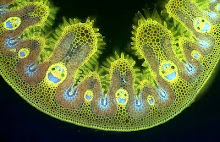When I was a kid my grandfather used to make little boats with half-walnut shells, fitting them with a matchstick mast and paper sail. Their association with childhood pleasures goes back a long way - apparently the Romans had a ritual at weddings whereby the bridegroom threw walnuts to children, symbolising the casting off of childhood preoccupations and the beginning of adult life.
One of the many botanically interesting aspects of walnuts is that they are not - botanically speaking - nuts. They are classified as drupes - fruits with a fleshy outer coating and a single hard seed inside, which groups them with peaches and plums whose outer coat is succulent. The tough outer coat of walnuts eventually splits to release the hard seed inside but it has its own special properties - it produces a deep brown dye. I discovered this for myself by accident when I was showing some visitors around Durham University Botanic Garden and picked up a fallen fruit and idly pulled it apart to show them the walnut seed inside - and it took three days for the brown stains to disappear from my fingers.
For about twenty years I had a walnut tree in my own small garden but it was foolish to plant such a fast-growing forest tree in such a small plot. It quickly outgrew the garden and I had to cut it down - and that revealed another interesting sensory aspect of the tree - its foliage and wood have a distinctive fragrance, that to me smells of apricots.
Walnut produces male and female reproductive structures separately on the same tree (monoecy) - the male flower being these fat catkins....
........... and the female being the ovary with a short style and twin stigmas that you can see between the leaf stalks at the top of the picture above. Solitary trees sometimes fail to produce nuts because there is a time differential between stigmas becoming receptive and the catkins shedding pollen (dichogamy).
Aside from its edible 'nuts', which were always an enduring feature of Christmas in our house when I was a child (no one could ever find the nut-crackers, which were not as elegant as the pair you can see here), walnut is famous for the beauty of its timber which is widely used for cabinet-making and for gun stocks. The tree originates from extreme south-east Europe and the Near-East (hence the alternative name Persian walnut) and can be killed in extreme winters. In 1709 there was a winter in Europe that killed thousands of walnut trees, which were felled and bought by Dutch merchants who foresaw an impending shortage and made a handsome profit by cornering the market for walnut timber in the years before new trees could be established.
There is an old saying that walnut trees are more fruitful if their branches are beaten. The likely origin of this is that walnuts used to be harvested as soon as they began to ripen, while still attached to the tree, by knocking them down with long poles - otherwise birds and squirrels would get them first. This assault on the tree broke the tips of twigs and promoted the growth of fruiting spurs, producing a better crop of fruits in the following year.

















